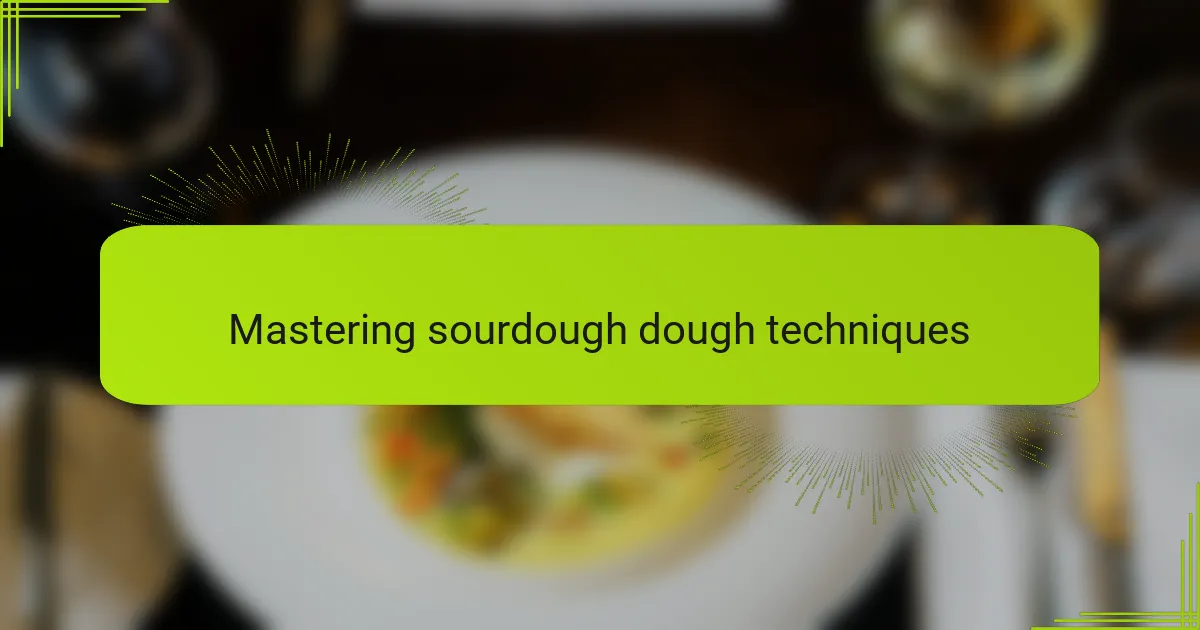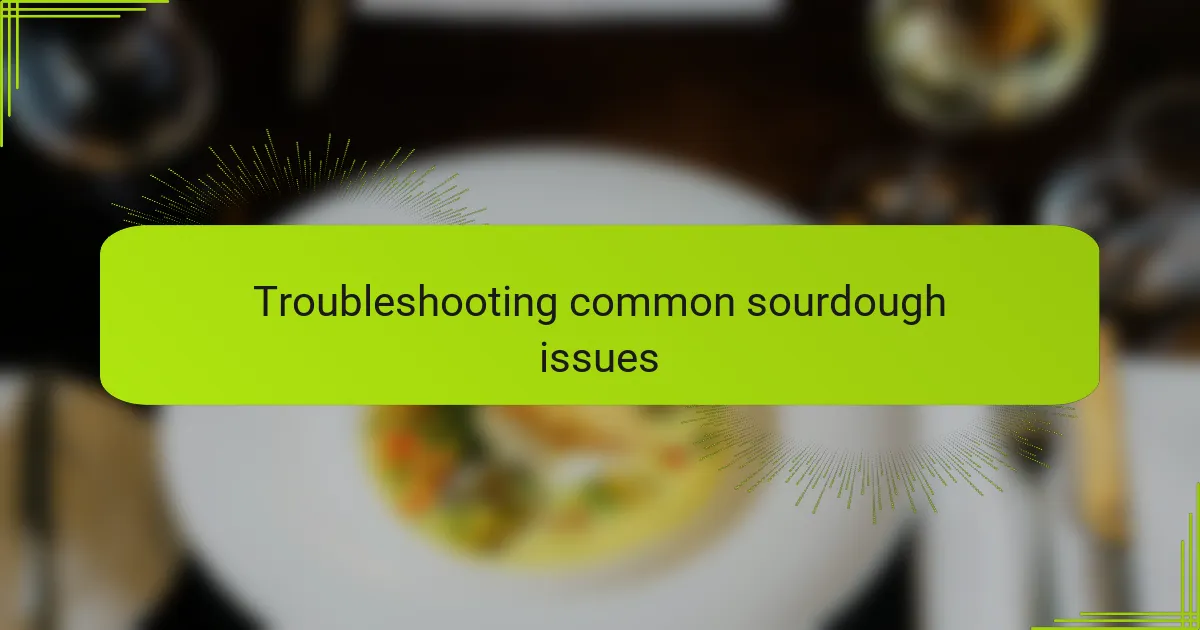Key takeaways
- Sourdough baking emphasizes patience and connection with the fermentation process, transforming it into a creative ritual.
- Essential tools include a digital kitchen scale, Dutch oven, and bench scraper to simplify and enhance the baking experience.
- Mastering techniques, such as gentle folding and proper hydration, significantly impacts the texture and quality of the final bread.
- Extending fermentation time and experimenting with different flours elevate the flavor complexity of sourdough creations.

Understanding sourdough basics
Sourdough, at its core, is simply flour, water, and time coming together in a beautiful dance of natural fermentation. I remember feeling both intimidated and fascinated by this process—how could wild yeast and bacteria, invisible to the eye, transform basic ingredients into something so soulful?
What struck me most was realizing that sourdough isn’t about rushing; it demands patience and attention, inviting you to slow down and connect with your food in a way I hadn’t experienced before. Have you ever paused to think about the tiny organisms working tirelessly in your dough? That thought alone makes the bread feel like a living, breathing partner in the kitchen.
Understanding this natural fermentation changed my approach: it’s less about control and more about trust, observation, and a willingness to learn. It transformed baking from a chore into a creative ritual, and that mindset shift made all the difference in my sourdough journey.

Essential tools for sourdough baking
One thing I quickly learned was that having the right tools makes the whole sourdough process feel less overwhelming. A good digital kitchen scale became my best friend—I couldn’t imagine trusting measurements without it. Precision matters so much here; it’s amazing how a few grams can change the texture of your loaf.
I also invested in a Dutch oven, which I found crucial for achieving that bakery-style crust at home. There’s something magical about the way it traps steam, giving the bread its signature crispiness. Without it, my loaves lacked that professional touch, and I felt like I was missing out.
Last but not least, I swear by a simple bench scraper. It might seem minor, but this tool saved me countless times when handling sticky dough. It’s like an extension of your hand, helping you fold, divide, and shape without frustration. Have you ever tried wrestling a stubborn dough ball? This little scraper makes it manageable and even enjoyable.

Preparing your sourdough starter
Starting a sourdough starter felt like inviting a tiny, mysterious world into my kitchen. I mixed equal parts flour and water, watching the blend bubble and shift over days, almost like nurturing a curious pet. Have you noticed how those early bubbles bring such a thrill—proof that life is quietly stirring?
Feeding the starter became a daily ritual that grounded me, a moment of calm where I connected with the process beyond just baking. I learned to discard part of the mixture before adding fresh flour and water—at first it felt wasteful, but now I see it as making space for the starter to thrive.
Timing was another surprise: the starter takes on different aromas and strengths depending on the environment and how often I feed it. I came to understand that patience wasn’t just waiting; it was learning to listen to how my starter wanted to develop in its own unique way.

Mastering sourdough dough techniques
Mastering sourdough dough techniques was a turning point for me—I soon realized it’s all about rhythm and feel more than strict rules. For instance, learning the art of folding rather than heavy kneading helped me nurture the gluten gently, producing a crumb that was both airy and tender. Have you ever tried folding dough in silence, feeling its texture change beneath your fingers? That tactile connection became my favorite part of baking.
Hydration was another tricky but rewarding puzzle. I used to underestimate how a wetter dough could feel sticky and intimidating, but embracing that stickiness taught me patience and trust in the fermentation process. Adjusting water levels slightly, depending on the flour and environment, turned my dough from frustrating goo into a lively, elastic mass that promised a great loaf.
Shaping felt like an art form I had to learn patiently—each step influencing the final rise and crust. I remember the first time my dough held its shape beautifully, and it was like watching a sculpture come to life. Do you know that moment when you realize the dough is cooperating, not resisting? That’s when baking stops being a task and becomes pure joy.

Baking perfect sourdough desserts
Baking perfect sourdough desserts made me realize that the tangy complexity of sourdough adds a delightful depth to sweet treats, balancing richness with a subtle hint of acidity. Have you ever tasted a sourdough tart or cake and noticed that it feels both light and surprisingly flavorful? That contrast is what keeps me coming back to sourdough for dessert experiments.
I learned early on that timing is crucial—overproofing can turn your delicate soufflé into a dense disappointment, while underproofing leaves your crust lacking that perfect crunch. There’s a certain thrill in watching your batter rise and wobble just right, like waiting for a secret to reveal itself in the oven.
One technique I swear by is incorporating a bit of your active sourdough starter into batters or fillings, which not only enhances flavor but boosts the texture, giving desserts a wonderfully moist and tender crumb. It took a few tries to get the balance right, but once I did, my sourdough desserts gained a unique personality that no store-bought treat could match.

Troubleshooting common sourdough issues
One common snag I faced early on was dealing with a sluggish starter that just wouldn’t bubble like I hoped. I learned that temperature is a silent game-changer here—too cold and the yeast slows down, too warm and it can get overly active or spoil. Have you ever tried moving your starter to a warmer spot, like near a sunny window or on top of the fridge? That little shift made a massive difference for me.
Sometimes my dough turned out dense or flat, and I used to blame everything except the obvious—the timing. Overproofing is sneaky; it feels like the dough’s ready when it’s actually past its prime. I’ve come to rely on the poke test: gently pressing the dough and watching how it springs back slowly. It’s a simple touchstone that keeps me from that heartbreaking moment when the loaf deflates in the oven.
Then there’s the crust battle—too hard, too soft, or patchy gloss. I discovered that steam is everything. Using a Dutch oven helped me trap moisture, but when I didn’t have one, I improvised with a pan of water in the oven. Have you ever counted the minutes to the exact moment of steam release? It’s become a little ritual that keeps me connected to the process, turning stress into satisfaction.

Tips for enhancing sourdough flavors
One thing that truly deepened the flavor of my sourdough was extending the fermentation time. Giving the dough a longer, slower rise in the fridge—sometimes overnight—allowed the natural acids and wild yeast to develop those complex, tangy notes I came to crave. Have you tried that slow ferment? It’s almost like letting the dough tell its own story.
Another game changer for me was experimenting with different flours. Incorporating whole grain or rye flour brought an earthy depth that white flour alone couldn’t achieve. I remember the first time I added a bit of rye; the aroma instantly felt richer, and the flavor followed suit. It’s a small twist that rewards you with so much more character.
Lastly, I learned not to underestimate the power of hydration levels in flavor enhancement. Slightly wetter doughs seemed to encourage a more active fermentation, resulting in brighter, livelier sourdough flavors. I used to shy away from sticky dough, but embracing it really paid off in taste—sometimes, a little mess means a lot of magic. Have you ever felt that sticky stretch and thought, “this could be something special”? That’s when you know you’re on the right track.




